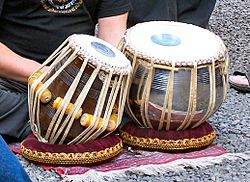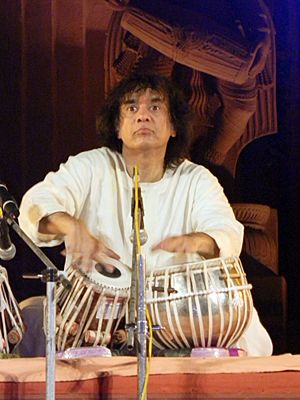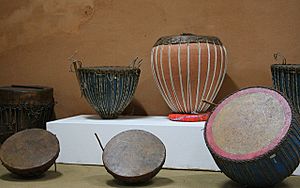Tabla facts for kids
 |
|
Quick facts for kids Percussion instrument |
|
|---|---|
| Classification | Indian percussion instrument, goatskin heads with syahi |
| Playing range | |
| Bolt tuned or rope tuned with dowels and hammer | |
| Related instruments | |
| Pakhavaj, mridangam, khol, dholak, nagara, madal, tbilat | |
The tabla is an Indian drum used for North Indian Music. The tabla invention is found in India. It is also used for classical, popular and devotional music of Pakistan. The instrument is two hand drums of different size and shape, similar to bongos. They make different sounds. The drums are treble and bass drum.
Tabla is played hitting the fingers on the drum head and sliding the palm to create a modulating sound. A lot of sounds can be created from the tabla by changing how you use your hands.
The tabla originated from the a more ancient cylindrical drum called the Pakhawaj.
Zakir Hussain is a notable tabla player. There are different Gharanas or houses of tabla. Zakir Hussain's style is of the Punjab Gharana.
Contents
Origins
The history of tabla is unclear, and there are multiple theories regarding its origins. There are two groups of theories, one that traces its origins to Muslim and Mughal conquerors of the Indian subcontinent, the other traces it to indigenous origins. One example of the latter theory is carvings in Bhaja Caves. However, clear pictorial evidence of the drum emerges only from about 1745, and the drum continued to develop in shape until the early 1800s.
Indian origins
The Indian theory traces the origin of tabla to indigenous ancient civilization. The stone sculpture carvings in Bhaja Caves depict a woman playing a pair of drums, which some have claimed as evidence for the ancient origin of the tabla in India. A different version of this theory states that the tabla acquired a new Arabic name during the Islamic rule, having evolved from ancient Indian puskara drums. The evidence of the hand-held puskara is founded in many temple carvings, such as at the 6th and 7th century Muktesvara and Bhuvaneswara temples in India. These arts show drummers who are sitting, with two or three separate small drums, with their palm and fingers in a position as if they are playing those drums. However, it is not apparent in any of these ancient carvings that those drums were made of the same material and skin, or played the same music, as the modern tabla.
The textual evidence for similar material and methods of construction as tabla comes from Sanskrit texts. The earliest discussion of tabla-like musical instrument building methods are found in the Hindu text Natyashastra. This text also includes descriptions of paste-patches (syahi) such as those found on a tabla. The Natyashastra also discusses how to play these drums. The South Indian text Silappatikaram, likely composed in the early centuries of 1st millennium CE, describes thirty types of drums along with many stringed and other instruments. These are, however, called pushkara; the name tabla appears in later periods.
Muslim and Mughal origins
This theory is based on the etymological links of the word tabla to Arabic word tabl which means "drum". Beyond the root of the word, this proposal points to the documentary evidence that the Muslim armies had hundreds of soldiers on camels and horses carrying paired drums as they invaded the Indian subcontinent. They would beat these drums to scare the residents, the non-Muslim armies, their elephants and chariots, that they intended to attack. However, the war drums did not look or sound anything like tabla, they were large paired drums and were called naqqara (noise, chaos makers).
Another version states that Amir Khusraw, a musician patronized by Sultan Alauddin Khalji invented the tabla when he cut an Awaj drum, which used to be hourglass shaped, into two parts. However, no painting or sculpture or document dated to his period supports it with this evidence nor it was found in the list of musical instruments that were written down by Muslim historians. For example, Abul Fazi included a long list of musical instruments in his Ain-i-akbari written in the time of the 16th century Mughal Emperor Akbar, the generous patron of music. Abul Fazi's list makes no mention of tabla.
The third version credits the invention of tabla to the 18th century musician, with a similar sounding name Amir Khusru, where he is suggested to have cut a Pakhawaj into two to create tabla. Miniature paintings of this era show instruments that sort of look like tabla. This theory implies that tabla emerged from within the Muslim community of Indian subcontinent and were not an Arabian import. However, scholars such as Neil Sorrell and Ram Narayan state that this legend of cutting a pakhawaj drum into two to make tabla drums "cannot be given any credence".
History

Drums and Talas are mentioned in the Vedic era texts. A percussion musical instrument with two or three small drums, held with strings, called Pushkara (also spelled Pushkala) were in existence in pre-5th century Indian subcontinent along with other drums such as the Mridang, but these are not called tabla then. The pre-5th century paintings in the Ajanta Caves, for example, show a group of musicians playing small tabla-like upright seated drums, a kettle-shaped mridang drum and cymbals. Similar artwork with seated musicians playing drums, but carved in stone, are found in the Ellora Caves, and others.
A type of small Indian drums, along with many other musical instruments, are also mentioned in Tibetan and Chinese memoirs written by Buddhist monks who visited the Indian subcontinent in the 1st millennium CE. The pushkala are called rdzogs pa (pronounced dzokpa) in Tibetan literature. The pushkara drums are also mentioned in many ancient Jainism and Buddhism texts, such as Samavayasutra, Lalitavistara and Sutralamkara.
Various Hindu and Jain temples, such as the Eklingji in Udaipur, Rajasthan show stone carvings of a person playing tabla-like small pair of drums. Small drums were popular during the Yadava rule (1210 to 1247) in the south, at the time when Sangita Ratnakara was written by Sarangadeva. Madhava Kandali, 14th century Assamese poet and writer of Saptakanda Ramayana, lists several instruments in his version of "Ramayana", such as tabal, jhajhar, dotara, vina, bīn, vipanchi, etc. (meaning that these instruments existed since his time in 14th century or earlier).There is recent iconography of the tabla dating back to 1799. This theory is now obsolete with iconography carvings found in Bhaje caves providing solid proof that the tabla was used in ancient India. There are Hindu temple carvings of double hand drums resembling the tabla that date back to 500 BCE. The tabla was spread widely across ancient India. A Hoysaleshwara temple in Karnataka shows a carving of a woman playing a tabla in a dance performance.
According to classifications of musical instruments defined in the Natyashastra, Tabla is classified in the Avanadha Vadya category of rhythm instruments which are made by capping an empty vessel with a stretched skin.
Construction and features
The tabla consists of two single-headed, barrel-shaped small drums of slightly different sizes and shapes: baya and daya for left and right drums, respectively.

The smaller drum, played with the dominant hand, is called dayan (literally "right" side), dāhina, siddha or chattū, but is correctly called the "tabla." It is made from a conical piece of mostly teak and rosewood hollowed out to approximately half of its total depth. The daya tabla is played by the musician's right hand (dominant hand), and is about 15 centimetres (~6 in) in diameter and 25 centimetres (~10 in) high. The drum is tuned to a specific note, usually either the tonic, dominant or subdominant of the soloist's key and thus complements the melody. This is the ground note of the raga called Sa (tonic in India music). The tuning range is limited although different dāyāñs are produced in different sizes, each with a different range. Cylindrical wood blocks, known as gatta, are inserted between the strap and the shell allowing tension to be adjusted by their vertical positioning. Fine tuning is achieved while striking vertically on the braided portion of the head using a small, heavy hammer. While tabla usually features two drums, a tabla tarang may consist of 10-16 dayas to perform melodies based on several ragas.
The baya tabla is a bit bigger and deep kettledrum shaped, about 20 centimetres (~8 in) in diameter and 25 centimetres (~10 in) in height. It played with the non-dominant hand, is called bāyāñ (literally "left") duggī or dhāmā (correctly called "dagga"), has a much deeper bass tone, much like its distant cousin, the kettle drum. The bāyāñs can be found to be made up of many different types of materials. Brass is the most common, copper is more expensive, but generally held to be the best, while aluminum and steel are often found in inexpensive models. Sometimes wood is used, especially in old bāyāñs from the Punjab. Clay is also used, although not favored for durability; these are generally found in the North-East region of Bengal. The baya construction and tuning is about a fifth to an octave below that of the daya drum. The musician uses his hand's heel pressure to change the pitch and tone colour of each drum during a performance.
The head of each drum has a central area of "tuning paste" called the syahi (lit. "ink"; a.k.a. shāī or gāb). Syahi is common in many drums of Indian origin. This method allows these drums to produce harmonic overtones and is responsible for their unique sound. Syahi is constructed using multiple layers of a paste made from starch (rice or wheat) mixed with a black powder of various origins. The precise construction and shaping of this area is responsible for modification of the drum's natural overtones, resulting in the clarity of pitch (see inharmonicity) and variety of tonal possibilities unique to this instrument which has a bell-like sound. The skill required for the proper construction of this area is highly refined and is the main differentiating factor in the quality of a particular instrument. The earliest discussion of these paste-patches are found in the Hindu text Natyashastra.
For stability while playing, each drum is positioned on a toroidal bundle called chutta or guddi, consisting of plant fiber or another malleable material wrapped in cloth. They are commonly played while sitting cross-legged on the floor.
Musical notation

Indian music is traditionally practice-oriented and until the 20th century did not employ written notations as the primary media of instruction, understanding, or transmission. The rules of Indian music and compositions themselves are taught from a guru to a shishya, in person. Thus oral notation for playing tabla strokes and compositions is very developed and exact. These are made up of onomatopoetic syllables and are known as bols.
Written notation is regarded as a matter of taste and is not standardized. Thus there is no universal system of written notation for the rest of the world to study Indian music. The two popular systems for writing notations were created by Vishnu Digambar Paluskar and Vishnu Narayan Bhatkhande. These notations are named after their respective creators. Both these systems have bols written down in a script such as Latin or Devanagari. The differences arise in representation of various concepts of a compositions, such as Taali, Khaali, Sum (the first beat in a rhythmic cycle), and Khand (divisions). Another difference is the use of numerals in the Vishnu Narayan Bhatkande system to represent matras and beat measures, whereas more sophisticated symbols are used in the Vishnu Digambar Paluskar system to denote one matra, its fractions and combinations.
Other Images
See also
 In Spanish: Tabla (instrumento de percusión) para niños
In Spanish: Tabla (instrumento de percusión) para niños



